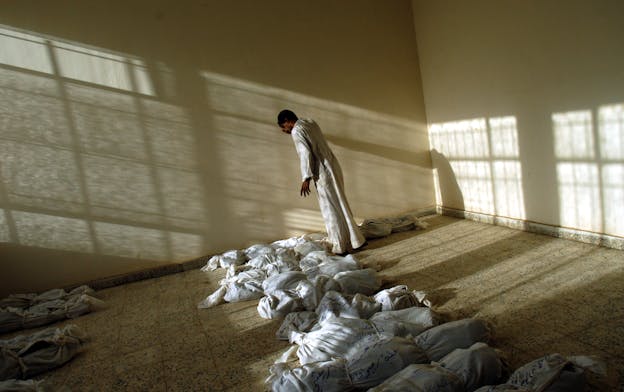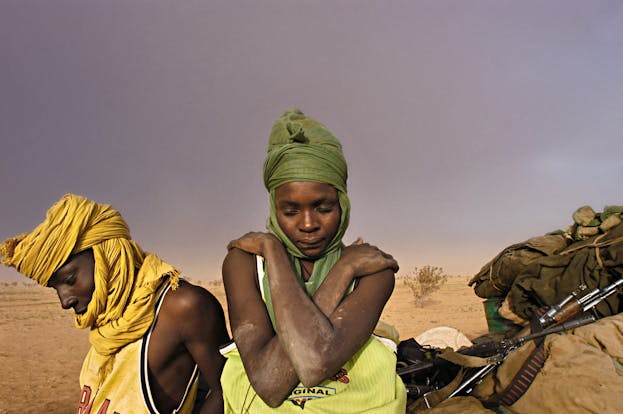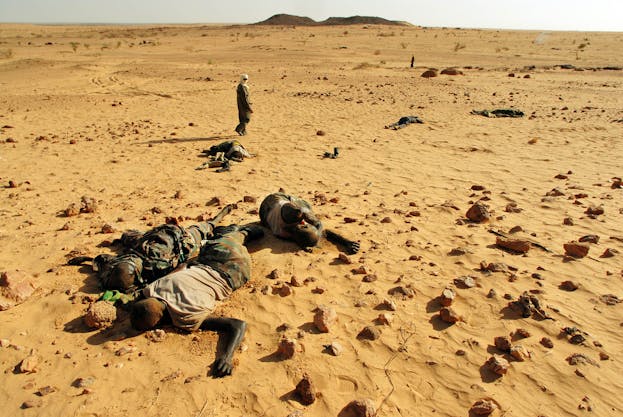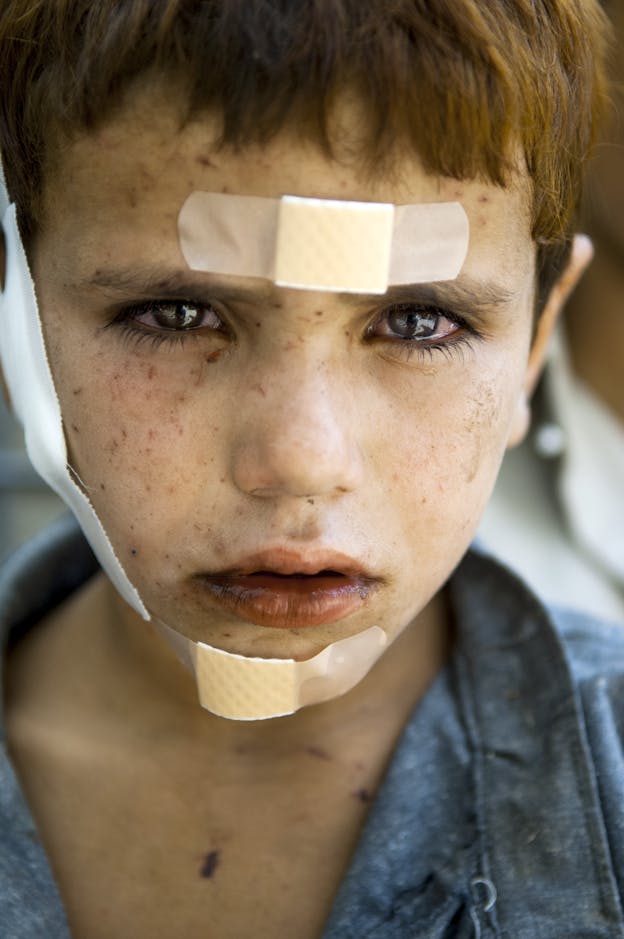Lynsey Addario received her first camera when she was thirteen. In her new memoir, It’s What I Do: A Photographer’s Life of Love and War, she remembers being too shy to photograph people, instead focusing on “flowers, cemeteries, peopleless landscapes.” Today, Addario is one of America’s most accomplished war photographers, having traveled to some of the most dangerous places on earth: Afghanistan, Iraq, Libya, Darfur, Congo. (She’s been kidnapped twice, and two of her drivers have been killed.)
Addario's work is regularly featured in The New York Times and National Geographic. The winner of a MacArthur "genius" grant, she was on a team that won a Pulitzer Prize in 2009 for International Reporting. We selected five photos from Addario’s memoir and asked her to tell us the story behind each one.

Lynsey Addario: This was in 2000 when Afghanistan was under the Taliban. Photography was not permissible at that time. Photography of any living being, according to Taliban rule, was illegal. So when I went to Afghanistan, immediately I was worried about photographing people. But it was what I wanted: to show what life was like under the Taliban, specifically for women.
Because I'm a woman, I was able to go in the [women’s] hospital and the minder [appointed by the Taliban government] who was with me was not allowed inside. When I walked in this room, all the women covered their faces. I asked to take pictures, naturally. You always have to ask in Afghanistan. Because the women were not identifiable, they all said yes.

LA: This is shortly after Saddam fell. We heard that there were mass graves found around an area called Hillah. We went down to the area, and literally the earth had been dug up in an area that just sprawled. I'm not sure how big—at least the size of a soccer field. People were just pulling out plastic bags with remnants of bodies. These were Shiite families that Saddam had killed the male relatives in a lot of cases, and the families had never recovered the bodies. People were pulling out plastic bags full of bones, in some instances there were name tags, there were shreds of clothing that were still left. It was an unbelievable scene, and people were just completely devastated. Everyone just started weeping and screaming.
Very close to there—that sort of open grave—was this building. Inside they had brought many of those bags of the remnants of bodies and laid them out on the floor, and in each room there was one or two people just sort of weeping, crying quietly. And it really, to me it was—I had never seen a mass grave, I had never seen anything like that. It was very overwhelming in terms of, how do I capture this in a single photograph, and how do I this in a way that will transmit the gravity and the devastation that I'm seeing?

LA: That's my first trip into Darfur, and those are rebel fighters. Everyone thinks those are women—they’re men actually.
In 2004 I entered Darfur with Somini Sengupta from the New York Times, and Jehad Nga and Jahi Chickwendui, working for the Washington Post. We all travelled around with a truckload of rebels and were there to document what was going on. And it was very, very early on in the war there, and the very few people actually privy to what was actually happening on the ground in Darfur. We were driven around to see burnt down villages, bodies, fleeing civilians. We were 17 rebel fighters on the back of one pickup truck, and the rebels had no resources. I mean, literally, that truck broke down every few hours at a minimum. And we were driving clear across the Sahel, the desert. It was just sand from horizon to horizon. And the truck just kept breaking down.
In this particular picture, the truck had broken down and a sandstorm was coming, but yet there was this unbelievably beautiful light. The two rebels just seemed so calm, they were not flustered at all with the fact that the truck kept breaking down. They were just kind of hanging out, and it just seemed like one of those unique, beautiful moments in the middle of a really devastating place.

LA: That was in 2006, and I was traveling with Lydia Polgreen from the New York Times. We had heard that Sunni government soldiers had been attacked by the rebels, and that dozens were killed. And President Bashir, the Sudanese president, would deny that, saying it was absolutely not true, there was no attack against government soldiers, it was a lie.
The only way to verify something like that was to try and get in. Lydia and I were in Chad, which is bordering Darfur. We went to the border to a group of rebels and said, "Hey, can you take us to this place? We heard there was a massacre." And they said, "Yeah but there are Antonovs flying overhead," [which are] the Russian aircraft that the government often used to bomb. They said you'd basically go at your own risk. And so we said we'll take the risk, we've got to go report.
We drove into Darfur and when we got there, there were bodies everywhere. And they were government soldiers. We did not stay on the ground very long because it was incredibly dangerous. But we got the scene and the picture was on the cover of the New York Times, and Lydia wrote an incredible article. That picture to me is really a testament to the power of photography, and the power of journalism. And it provides proof to something a government was trying to deny.

LA: [Elizabeth Rubin] had a brilliant idea of trying to answer the question of why there were so many civilian casualties in Afghanistan, if we had the greatest technology. So we parachuted into the Korengal Valley, which was one of the most dangerous places in Afghanistan at the time. When we got there we went first to the command headquarters. We spent a few days in the tactical operations center. There we watched how they dropped bombs, where they dropped them, troops in combat, drone feeds—all sorts of the information the troops used in order to figure out where to engage.
The night before we flew into one of the remote outposts, there was a big combat. We witnessed the whole thing unfolding. Eventually the commander decided to drop—I think one or two bombs—on this one area. The next day we flew into that area. As we came in, a family of Afghans showed up and they were asking for assistance. They said they had been wounded in the bombing the night before, in the exact location that we knew the bombs were dropped. I photographed this young boy, Khalid, getting treated. Then I spoke to the medic [who] said, “Well, these wounds are not consistent with shrapnel.” The military never wants to admit that they've injured civilians. So I, as a journalist, put that in my caption, knowing that I would go back and fix it, and put in my reporting. But we ended up spending two months in the Korengal Valley, something I didn't anticipate.
Months later, when I filed pictures for the New York Times, I had never fixed that caption. So when those pictures went to the editor, he had doubts about whether that boy was really injured in a U.S. assault. I explained that we witnessed it—I just never fixed the captions. The editor went and fact-checked that with one of the military guys [who] obviously den[ied] it. The whole point of the image of Khalid is that there is ambiguity in war. That is part of our job as journalists: We need to show what we see and we need to explain the situation. Then it's up to people to decide.
The picture was never published. The editor decided not to run the photo, struck it from the layout entirely. He wouldn't even run it in the slideshow.
Interview has been condensed and lightly edited for length and clarity.
